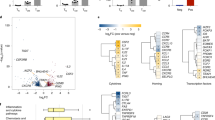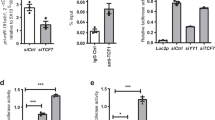Abstract
After being activated by antigen, helper T lymphocytes switch from a resting state to clonal expansion. This switch requires inactivation of the transcription factor Foxo1, a suppressor of proliferation expressed in resting helper T lymphocytes. In the early antigen-dependent phase of expansion, Foxo1 is inactivated by antigen receptor–mediated post-translational modifications. Here we show that in the late phase of expansion, Foxo1 was no longer post-translationally regulated but was inhibited post-transcriptionally by the interleukin 2 (IL-2)-induced microRNA miR-182. Specific inhibition of miR-182 in helper T lymphocytes limited their population expansion in vitro and in vivo. Our results demonstrate a central role for miR-182 in the physiological regulation of IL-2-driven helper T cell–mediated immune responses and open new therapeutic possibilities.
This is a preview of subscription content, access via your institution
Access options
Subscribe to this journal
Receive 12 print issues and online access
$209.00 per year
only $17.42 per issue
Buy this article
- Purchase on Springer Link
- Instant access to full article PDF
Prices may be subject to local taxes which are calculated during checkout






Similar content being viewed by others
References
Iezzi, G., Karjalainen, K. & Lanzavecchia, A. The duration of antigenic stimulation determines the fate of naive and effector T cells. Immunity 8, 89–95 (1998).
van Stipdonk, M.J., Lemmens, E.E. & Schoenberger, S.P. Naive CTLs require a single brief period of antigenic stimulation for clonal expansion and differentiation. Nat. Immunol. 2, 423–429 (2001).
Jelley-Gibbs, D.M., Lepak, N.M., Yen, M. & Swain, S.L. Two distinct stages in the transition from naive CD4 T cells to effectors, early antigen-dependent and late cytokine-driven expansion and differentiation. J. Immunol. 165, 5017–5026 (2000).
Peng, S.L. Foxo in the immune system. Oncogene 27, 2337–2344 (2008).
Pellegrini, M. et al. Loss of Bim increases T cell production and function in interleukin 7 receptor-deficient mice. J. Exp. Med. 200, 1189–1195 (2004).
Fabre, S. et al. Stable activation of phosphatidylinositol 3-kinase in the T cell immunological synapse stimulates Akt signaling to FoxO1 nuclear exclusion and cell growth control. J. Immunol. 174, 4161–4171 (2005).
Xu, S., Witmer, P.D., Lumayag, S., Kovacs, B. & Valle, D. MicroRNA (miRNA) transcriptome of mouse retina and identification of a sensory organ-specific miRNA cluster. J. Biol. Chem. 282, 25053–25066 (2007).
Krek, A. et al. Combinatorial microRNA target predictions. Nat. Genet. 37, 495–500 (2005).
Lewis, B.P., Shih, I.H., Jones-Rhoades, M.W., Bartel, D.P. & Burge, C.B. Prediction of mammalian microRNA targets. Cell 115, 787–798 (2003).
Orom, U.A., Kauppinen, S. & Lund, A.H. LNA-modified oligonucleotides mediate specific inhibition of microRNA function. Gene 372, 137–141 (2006).
Rochman, Y., Spolski, R. & Leonard, W.J. New insights into the regulation of T cells by γc family cytokines. Nat. Rev. Immunol. 9, 480–490 (2009).
Muller, J., Sperl, B., Reindl, W., Kiessling, A. & Berg, T. Discovery of chromone-based inhibitors of the transcription factor STAT5. ChemBioChem 9, 723–727 (2008).
Paust, S. & Cantor, H. Regulatory T cells and autoimmune disease. Immunol. Rev. 204, 195–207 (2005).
Oxenius, A. et al. Functional in vivo MHC class II loading by endogenously synthesized glycoprotein during viral infection. J. Immunol. 158, 5717–5726 (1997).
Stahl, M. et al. The forkhead transcription factor FoxO regulates transcription of p27Kip1 and Bim in response to IL-2. J. Immunol. 168, 5024–5031 (2002).
Dijkers, P.F. et al. Forkhead transcription factor FKHR-L1 modulates cytokine-dependent transcriptional regulation of p27KIP1. Mol. Cell. Biol. 20, 9138–9148 (2000).
Dijkers, P.F., Medema, R.H., Lammers, J.W., Koenderman, L. & Coffer, P.J. Expression of the pro-apoptotic Bcl-2 family member Bim is regulated by the forkhead transcription factor FKHR-L1. Curr. Biol. 10, 1201–1204 (2000).
Brunet, A. et al. Akt promotes cell survival by phosphorylating and inhibiting a Forkhead transcription factor. Cell 96, 857–868 (1999).
Ouyang, W., Beckett, O., Flavell, R.A. & Li, M.O. An essential role of the Forkhead-box transcription factor Foxo1 in control of T cell homeostasis and tolerance. Immunity 30, 358–371 (2009).
Kerdiles, Y.M. et al. Foxo1 links homing and survival of naive T cells by regulating L-selectin, CCR7 and interleukin 7 receptor. Nat. Immunol. 10, 176–184 (2009).
Essaghir, A., Dif, N., Marbehant, C.Y., Coffer, P.J. & Demoulin, J.B. The transcription of FOXO genes is stimulated by FOXO3 and repressed by growth factors. J. Biol. Chem. 284, 10334–10342 (2009).
Al-Mubarak, B., Soriano, F.X. & Hardingham, G.E. Synaptic NMDAR activity suppresses FOXO1 expression via a cis-acting FOXO binding site: FOXO1 is a FOXO target gene. Channels (Austin) 3, 233–238 (2009).
Rowell, E.A., Walsh, M.C. & Wells, A.D. Opposing roles for the cyclin-dependent kinase inhibitor p27kip1 in the control of CD4+ T cell proliferation and effector function. J. Immunol. 174, 3359–3368 (2005).
Wells, A.D., Walsh, M.C., Sankaran, D. & Turka, L.A. T cell effector function and anergy avoidance are quantitatively linked to cell division. J. Immunol. 165, 2432–2443 (2000).
Naramura, M. et al. c-Cbl and Cbl-b regulate T cell responsiveness by promoting ligand-induced TCR down-modulation. Nat. Immunol. 3, 1192–1199 (2002).
Valitutti, S., Muller, S., Cella, M., Padovan, E. & Lanzavecchia, A. Serial triggering of many T-cell receptors by a few peptide-MHC complexes. Nature 375, 148–151 (1995).
Salio, M., Valitutti, S. & Lanzavecchia, A. Agonist-induced T cell receptor down-regulation: molecular requirements and dissociation from T cell activation. Eur. J. Immunol. 27, 1769–1773 (1997).
Muljo, S.A. et al. Aberrant T cell differentiation in the absence of Dicer. J. Exp. Med. 202, 261–269 (2005).
Szabo, S.J. et al. A novel transcription factor, T-bet, directs Th1 lineage commitment. Cell 100, 655–669 (2000).
Dooms, H., Wolslegel, K., Lin, P. & Abbas, A.K. Interleukin-2 enhances CD4+ T cell memory by promoting the generation of IL-7Rα-expressing cells. J. Exp. Med. 204, 547–557 (2007).
Long, D. et al. Potent effect of target structure on microRNA function. Nat. Struct. Mol. Biol. 14, 287–294 (2007).
Guttilla, I.K. & White, B.A. Coordinate regulation of FOXO1 by miR-27a, miR-96, and miR-182 in breast cancer cells. J. Biol. Chem. 284, 23204–23216 (2009).
Krutzfeldt, J. et al. Silencing of microRNAs in vivo with 'antagomirs'. Nature 438, 685–689 (2005).
Wang, V. & Wu, W. MicroRNA-based therapeutics for cancer. BioDrugs 23, 15–23 (2009).
Richter, A., Lohning, M. & Radbruch, A. Instruction for cytokine expression in T helper lymphocytes in relation to proliferation and cell cycle progression. J. Exp. Med. 190, 1439–1450 (1999).
Chang, H.D. et al. Expression of IL-10 in Th memory lymphocytes is conditional on IL-12 or IL-4, unless the IL-10 gene is imprinted by GATA-3. Eur. J. Immunol. 37, 807–817 (2007).
Lexberg, M.H. et al. Th memory for interleukin-17 expression is stable in vivo. Eur. J. Immunol. 38, 2654–2664 (2008).
Dong, J. et al. IL-10 is excluded from the functional cytokine memory of human CD4+ memory T lymphocytes. J. Immunol. 179, 2389–2396 (2007).
Niesner, U. et al. Autoregulation of Th1-mediated inflammation by twist1. J. Exp. Med. 205, 1889–1901 (2008).
Quah, B.J., Warren, H.S. & Parish, C.R. Monitoring lymphocyte proliferation in vitro and in vivo with the intracellular fluorescent dye carboxyfluorescein diacetate succinimidyl ester. Nat. Protocols 2, 2049–2056 (2007).
Mashreghi, M.F. et al. Inhibition of dendritic cell maturation and function is independent of heme oxygenase 1 but requires the activation of STAT3. J. Immunol. 180, 7919–7930 (2008).
Acknowledgements
We thank T. Berg (Max Planck Institute for Biochemistry) for the STAT5 inhibitor; D. Trono (École Polytechnique Fédérale de Lausanne) for the plasmid pLVTHM; H. Schliemann, T. Geske, H. Hecker-Kia, A. Peddinghaus, T. Kaiser and J. Kirsch for technical assistance; and Miltenyi Biotec for the miRXplore microarray experiments. Supported by Deutsche Forschungsgemeinschaft (GRK1121 for A.-B.S. and A.N.H.; and SFB 618, SFB 650, SFB 633 and SFB TR52), the International Max Planck Research School for Infectious Diseases and Immunology (C.H.), the Volkswagen Foundation (M.L.), the FORSYS (Forschungseinheiten zur Systembiologie) program of the Federal Ministry of Education and Research and the European Union MUGEN (Integrated Functional Genomics in Mutant Mouse Models as Tools to Investigate the Complexity of Human Immunological Disease) Network of Excellence.
Author information
Authors and Affiliations
Contributions
A.-B.S. designed and did experiments, analyzed data and wrote the manuscript; C.H. did experiments and analyzed data; E.S. designed and did the OVA-induced arthritis experiments; A.A.K. and C.L. did histology; A.N.H., I.P. and M.L. designed and analyzed LCMV experiments; R.R. did the OVA-induced arthritis experiments; M.F. and T.H. analyzed CFSE measurements; J.D. and A.T. did human T cell experiments; F.F. provided cells; G.A.H. did inhibitory experiments; N.L., Z.F., U.B., A.B., J.G., H.-J.M., W.C. and N.R. did miRNA screening experiments and/or analyzed them; N.R., M.L. and Z.F. discussed the results and commented on the manuscript; F.H. revised the manuscript; A.J. constructed scrambled overexpression vector; B.H., M.M., F.-M.S. and R.B. provided technical support and conceptual advice; H.-D.C. designed experiments and supervised research; A.R. designed study, supervised research and wrote the manuscript; and M.-F.M. designed the study, analyzed data and wrote the manuscript.
Corresponding author
Ethics declarations
Competing interests
U.B. and A.B. are employees of Miltenyi Biotec.
Supplementary information
Supplementary Text and Figures
Supplementary Figures 1–6 and Supplementary Table 1 (PDF 2122 kb)
Rights and permissions
About this article
Cite this article
Stittrich, AB., Haftmann, C., Sgouroudis, E. et al. The microRNA miR-182 is induced by IL-2 and promotes clonal expansion of activated helper T lymphocytes. Nat Immunol 11, 1057–1062 (2010). https://doi.org/10.1038/ni.1945
Received:
Accepted:
Published:
Issue Date:
DOI: https://doi.org/10.1038/ni.1945



